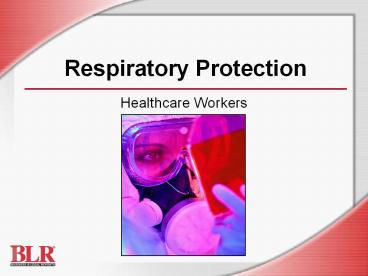Respiratory Protection - PowerPoint PPT Presentation
Title:
Respiratory Protection
Description:
Respiratory Protection Healthcare Workers Session Objectives You will be able to: Recognize respiratory hazards in your job Identify and use appropriate respiratory ... – PowerPoint PPT presentation
Number of Views:626
Avg rating:3.0/5.0
Title: Respiratory Protection
1
Respiratory Protection
- Healthcare Workers
2
Session Objectives
- You will be able to
- Recognize respiratory hazards in your job
- Identify and use appropriate respiratory
protection - Get a good, safe fit when using a respirator
- Inspect, maintain, and store respirators properly
3
What You Need to Know
- The facilitys respiratory protection program
- OSHA requirements
- Respiratory hazards
- Capabilities and limitations of respirators
- Respirator selection, fit, inspection, cleaning,
and storage
4
When Do You Need to Wear a Respirator?
- When airborne levels of a hazardous substance are
higher than the PEL - When you work with or around TB patients
- For emergency response operations
Image Credit RAE Systems
5
The Facilitys Respiratory Protection Program
- Written operating procedures
- Respirator selection, use, training, and fitting
- Respirator maintenance, storage, and inspection
- Work area surveillance
- Medical examinations
- Evaluation
6
Respiratory Hazards
- Hazardous substances that release airborne
contaminants - Chemical spill cleanups
- TB bacteria
- Some laboratory procedures
- Laser plumes
Image Credit WISHA
7
Respiratory Hazards (cont.)
- Inhaling some substances can cause
- Lung and tissue damage or irritation
- Respiratory diseases
- Cancer and other serious illness
- Death
8
Respiratory Hazards (cont.)
- Dont depend on smell or vision to identify
contaminants - Dont rely on surgical masks or dust masks to
protect you from all hazards
9
Respiratory Protection Hazards and Requirements
- Do you understand the information that has been
presented so far?
10
Two Basic Types of Respirators
- Air-purifying respirators
- Atmosphere-supplying respirators
Photo credit OSHA
Photo credit OSHA
11
Selecting the Right Respirator
- Hazards determine respirator selection
- MSDSs provide recommendations
- You will be told what kind of respirator to use
12
Getting the Right Fit
- Fits securely but not too tightly
- Doesnt pinch nose
- Doesnt slip
- Leaves room to move head and talk
13
Getting the Right Fit (cont.)
- Qualitative test
- Quantitative test
- Retesting
14
Seal-Checking Your Respirator
- Positive pressure test
- Negative pressure test
Photo credit OSHA
15
Other Factors That Affect Fit
- Beards
- Eyeglasses
- Incompatible facial features
16
Not Everybody Can Wear a Respirator
- You may not be able to wear a respirator if you
have - Breathing problems
- A heart condition
- Claustrophobia
- Heat sensitivity
17
Inspect Respirators Before Each Use
- Check to make sure there are no
- Holes
- Cracks
- Deterioration
- Dents
- Loose connections
- And report any problems to your supervisor
18
Clean Respirators After Each Use
- Remove filters
- Wash and rinse
- Carefully replace valves
Photo credit WISHA
19
Clean Respirators After Each Use (cont.)
- Dry with cloth or air dry
- Reassemble, then test
- Dont reuse dust masks
20
Store Respirators Properly
- Protect equipment from damage, sunlight, or
contamination - Store respirator and dry cartridges in a clean
container or bag - Do not allow the face piece to be distorted
21
Safe Use of Respirators
- Do you understand the information presented about
respirator selection, fit, inspection, and
maintenance?
22
Key Points to Remember
- Understand the hazards of dangerous airborne
substances in your job - Always choose the right respirator for the
hazards you face - Know how to properly fit, use, inspect, clean,
and store respirators - Inspect respirators before each use
- Report problems with respirators immediately

